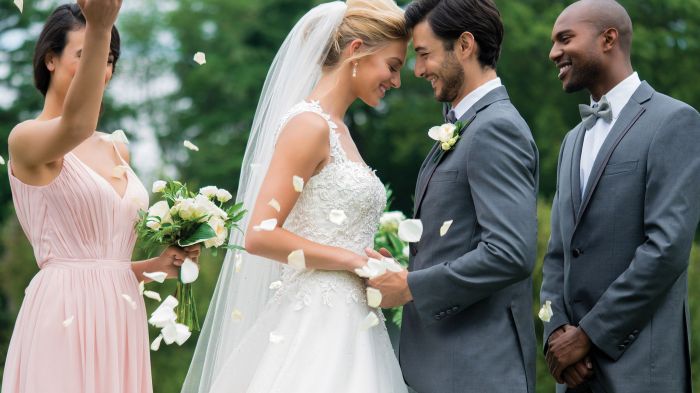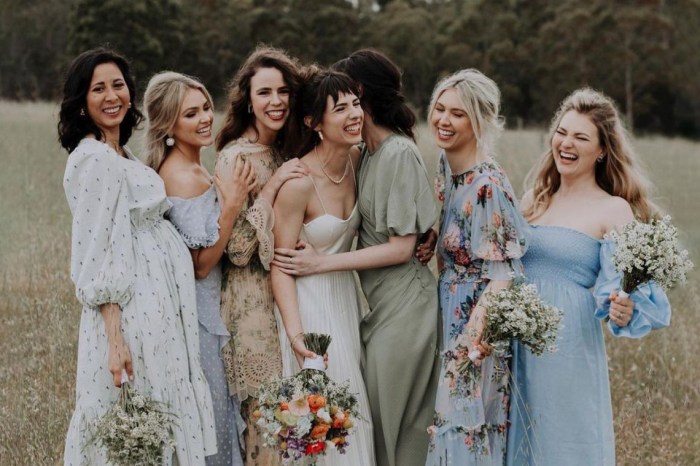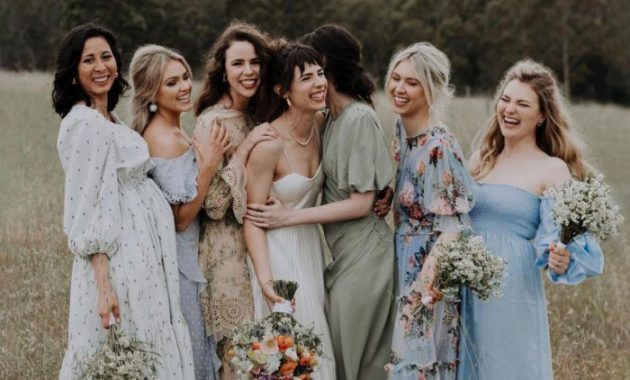Bridal Gown Styles
Bridal and groom wedding dress – The evolution of bridal gown styles reflects changing social norms, fashion trends, and technological advancements. From simple, practical garments to elaborate, highly-stylized creations, the bridal gown has undergone a significant transformation throughout history. Understanding these changes provides context for choosing a modern gown.
A Historical Overview of Bridal Gown Styles
Historically, bridal attire varied greatly depending on cultural and socioeconomic factors. Early gowns were often simple, reflecting the practicality of daily life. The Victorian era introduced more elaborate styles, with crinolines and bustles creating dramatic silhouettes. The early 20th century saw the rise of simpler, more streamlined designs, influenced by the flapper era. Post-war styles embraced fuller skirts and cinched waists, evolving into the diverse range of styles we see today.
Modern Bridal Gown Silhouettes

Source: greenweddingshoes.com
Choosing the perfect bridal and groom wedding attire is a significant undertaking, demanding careful consideration of style and comfort. Completing the look often involves selecting the right footwear, and for the bride, this might mean finding elegant sandals. A fantastic resource for finding the ideal pair is this selection of women’s dress sandals for wedding , ensuring both style and comfort complement the overall bridal and groom ensemble.
Ultimately, the right shoes can elevate the entire wedding day experience.
Modern bridal gowns offer a wide array of silhouettes to flatter various body types and personal styles. The A-line gown, characterized by its fitted bodice and gradually widening skirt, remains a classic choice for its flattering and versatile nature. The mermaid silhouette, with its close fit through the hips and a dramatic flare at the knees, offers a more dramatic and figure-hugging look.
Ballgowns, featuring full, voluminous skirts, exude elegance and romance, often ideal for formal weddings.
Necklines and Sleeve Styles in Bridal Gowns
Necklines and sleeves play a significant role in shaping the overall aesthetic of a bridal gown. Popular neckline options include sweetheart, V-neck, halter, and off-the-shoulder styles, each offering a unique look and feel. Sleeve styles range from sleeveless and short sleeves to long sleeves, three-quarter sleeves, and even detachable sleeves, providing versatility for various preferences and seasons.
Bridal Gown Styles by Fabric Type
The choice of fabric significantly impacts the drape, texture, and overall appearance of a bridal gown. Different fabrics offer distinct properties, influencing both the aesthetic and the comfort of the garment.
| Style | Fabric | Silhouette | Neckline |
|---|---|---|---|
| Classic A-line | Satin | A-line | Sweetheart |
| Bohemian Lace Gown | Lace | A-line | V-neck |
| Modern Mermaid | Silk | Mermaid | Off-the-shoulder |
| Romantic Ballgown | Tulle | Ballgown | High neck |
Groom’s Attire Options
The groom’s attire plays a crucial role in the overall aesthetic of the wedding. Choosing the right outfit complements the bride’s gown and reflects the wedding’s theme and style. Traditional elements, modern variations, and venue considerations all contribute to this important decision.
Traditional Elements of Groom’s Attire
Traditionally, a groom’s attire often includes a suit or tuxedo, typically in dark colors like navy or black. Accessories like a tie, vest, or pocket square add personality and sophistication. The choice of fabric, such as wool or silk, further enhances the overall look and feel.
Modern Variations on Traditional Groom’s Attire
Modern grooms are increasingly embracing variations on traditional attire. Suits in lighter colors or patterns, tuxedos with unique details, and even more unconventional choices like tailored separates or three-piece suits offer modern alternatives. The level of formality often dictates the style chosen.
Impact of Wedding Venue and Style on Groom’s Attire, Bridal and groom wedding dress
The wedding venue and style significantly influence the groom’s attire selection. A formal ballroom wedding might call for a classic tuxedo, while a rustic barn wedding might be better suited to a tailored suit in a lighter color or even a more relaxed outfit. The overall aesthetic should remain cohesive.
Coordinating Groom and Groomsmen Attire
Coordination between the groom and groomsmen’s attire ensures a polished and unified look. Several approaches achieve this effectively.
- Matching suits or tuxedos in the same color and style, with variations in tie or vest color.
- Similar suits or tuxedos, but with different colored ties or pocket squares to reflect individual personalities.
- Suits in complementary colors or patterns, maintaining a cohesive overall aesthetic.
Matching Bridal and Groom Attire

Source: cloudfront.net
Harmonizing the bride and groom’s attire is essential for a visually appealing and cohesive wedding aesthetic. Color palettes, complementary styles, and overall theme all play a crucial role in achieving this balance.
Key Factors in Selecting Coordinating Attire

Source: pressablecdn.com
Several factors contribute to successful coordination: the wedding’s theme and style, the venue, the season, and, of course, the bride and groom’s personal preferences. A cohesive look enhances the overall visual appeal and reflects the couple’s style.
The Influence of Color Palettes
Color palettes significantly impact the overall mood and feel of the wedding. Choosing colors that complement each other creates a harmonious visual experience. Consider the season, venue, and personal preferences when selecting a palette.
Different Approaches to Matching Attire
Several approaches create a cohesive look. Complementary colors offer a vibrant and visually striking effect. Monochromatic schemes, using various shades of a single color, provide a sophisticated and elegant look. A balance between these approaches often yields the best results.
Coordinated Outfit Examples
Here are three examples of coordinated outfits:
Classic Elegance: The bride wears a classic A-line gown in ivory satin with a sweetheart neckline, paired with a long veil. The groom wears a navy blue tuxedo with a crisp white shirt and a navy blue tie.
Modern Bohemian: The bride wears a flowy, lace A-line gown in blush pink with delicate floral embroidery. The groom wears a light grey suit with a blush pink tie and brown leather shoes.
Rustic Countryside: The bride wears a simple, elegant gown in cream-colored linen with delicate lace details. The groom wears a beige linen suit with a light blue shirt and brown leather boots.
Fabric and Materials
The choice of fabric significantly influences the look, feel, and durability of bridal and groom attire. Understanding the properties of different fabrics is crucial for making informed decisions.
Properties of Fabrics Used in Wedding Attire
Silk is known for its luxurious drape and sheen. Satin offers a smooth, glossy finish. Lace provides delicate texture and intricate detail. Wool offers warmth and durability, while linen is breathable and lightweight.
Durability, Comfort, and Care Requirements
Different fabrics require different levels of care. Silk and satin can be delicate and require special cleaning. Wool and linen are generally more durable and easier to care for. Comfort also varies, with linen being more breathable than silk or satin.
Impact of Fabric Choice on Overall Look and Feel
The fabric significantly impacts the overall aesthetic. Silk and satin create a luxurious and formal look, while linen offers a more relaxed and casual feel. Lace adds a romantic and delicate touch, while wool provides a classic and sophisticated look.
Fabric Comparison Table
| Fabric | Properties | Care | Suitability for Bridal/Groom Wear |
|---|---|---|---|
| Silk | Luxurious drape, sheen | Dry clean | Bridal gowns, ties |
| Satin | Smooth, glossy finish | Dry clean | Bridal gowns, groom’s shirts |
| Lace | Delicate texture, intricate detail | Dry clean | Bridal gowns, veils |
| Wool | Warm, durable | Dry clean or hand wash | Groom’s suits, tuxedos |
Illustrative Examples of Bridal and Groom Attire
Here are descriptions of various bridal and groom attire combinations for different wedding styles.
Classic, Elegant Combination
The bride wears a classic, ivory satin A-line gown with a sweetheart neckline and long sleeves. The groom wears a classic black tuxedo with a crisp white shirt and a black bow tie. The overall feel is timeless and sophisticated.
Modern, Bohemian Combination
The bride wears a flowing, bohemian-style gown in a soft blush pink, made from delicate lace. The gown features a V-neckline and long, flowing sleeves. The groom wears a light grey linen suit with a blush pink tie and brown leather shoes. The overall look is relaxed, romantic, and free-spirited.
Rustic, Countryside Combination
The bride wears a simple, elegant gown in a cream-colored linen with delicate lace details at the neckline and sleeves. The groom wears a beige linen suit with a light blue shirt and brown leather boots. The overall style is relaxed and comfortable, reflecting the rustic setting.
Formal, Black-Tie Combination
The bride wears a stunning, floor-length gown in rich, dark navy silk with a dramatic train. The groom wears a classic black tuxedo with a black bow tie, white shirt, and patent leather shoes. The overall aesthetic is formal, elegant, and sophisticated, perfect for a black-tie event.
FAQ Compilation: Bridal And Groom Wedding Dress
What are some eco-friendly options for bridal and groom attire?
Sustainable fabrics like organic cotton, hemp, and recycled materials are gaining popularity. Look for brands committed to ethical and sustainable practices.
How far in advance should I start shopping for wedding attire?
Ideally, begin searching 9-12 months before the wedding to allow ample time for alterations and potential delays.
What is the best way to clean my wedding dress and suit after the wedding?
Professional dry cleaning is recommended for both the bridal gown and groom’s attire to ensure proper care and preservation.
How can I incorporate my personal style into my wedding attire?
Choose fabrics, colors, and silhouettes that reflect your personality and preferences. Don’t be afraid to deviate from traditional styles and embrace unique elements.

